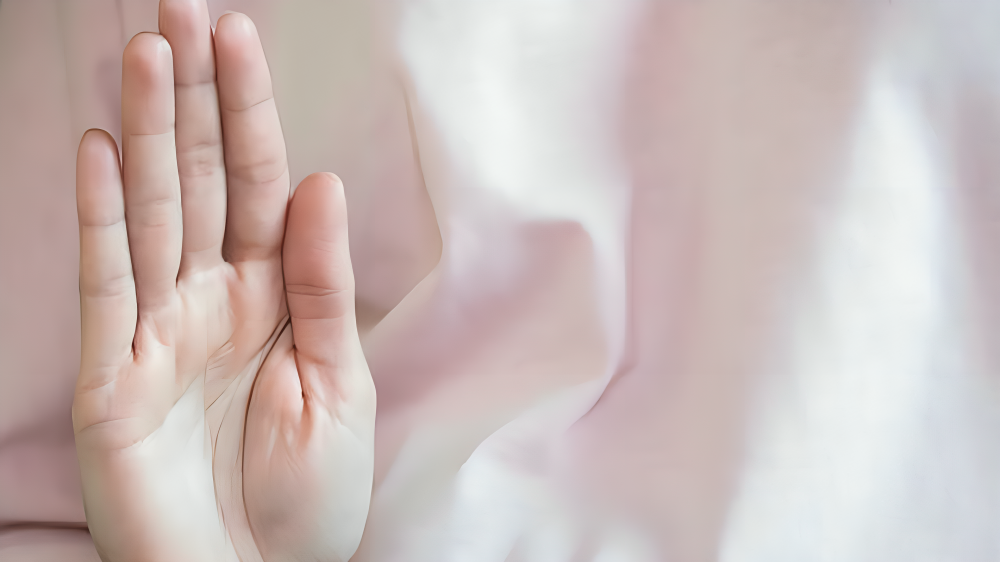
What is Abhaya Mudra?
The word “Abhaya” comes from Sanskrit, where “Abhaya” means “fearless” and “Mudra” means “gesture” or “seal.” So, Abhaya Mudra translates to the “gesture of fearlessness.” It’s often seen in Buddhist and Hindu art, where deities or enlightened beings are depicted with one hand raised in this gesture, symbolizing protection, peace, and the absence of fear.
How to Perform Abhaya Mudra
Find a Comfortable Position: Start by sitting comfortably. You can sit cross-legged on the floor, in a chair with your feet flat on the ground, or even stand if that’s more convenient.
Relax Your Body: Take a few deep breaths to relax your body. Let go of any tension in your shoulders, neck, and arms.
Raise Your Right Hand: Lift your right hand to chest level, keeping your fingers straight and together.
Palm Facing Outward: Ensure that your palm faces outward, away from your body, and that your fingers point upwards.
Rest Your Left Hand: Place your left hand on your lap or let it hang naturally by your side.
Focus on Your Breath: Close your eyes and focus on your breath. Breathe slowly and deeply, allowing the calming energy of the mudra to flow through you.
Hold the Position: Stay in this position for as long as you feel comfortable. It could be a few minutes or longer, depending on how you feel.
Benefits of Abhaya Mudra
Promotes Fearlessness: Abhaya Mudra is known for fostering a sense of courage and bravery. It can help you face challenges with a clear mind and a steady heart.
Enhances Confidence: By regularly practicing this mudra, you can build self-confidence. The gesture reinforces your belief in your own abilities and strengths.
Provides Protection: The gesture is believed to create a protective barrier around you, shielding you from negative energies and harmful thoughts.
Reduces Stress and Anxiety: Practicing this mudra can bring about a sense of calm and peace, helping to reduce feelings of stress and anxiety.
Boosts Positivity: Abhaya Mudra helps to cultivate a positive mindset. It encourages you to focus on the good things in life and to let go of fears that may be holding you back.
Supports Meditation: This mudra can deepen your meditation practice. It helps you center your mind, making it easier to enter a state of deep relaxation and awareness.
Bhairava Mudra: How to Practice and Unlock Its Powerful Benefits
FAQs
1. What does Abhaya Mudra mean?
Abhaya Mudra translates to the “gesture of fearlessness.” In Sanskrit, “Abhaya” means “fearless,” and “Mudra” means “gesture” or “seal.” It symbolizes protection, peace, and the absence of fear.
2. Can beginners practice Abhaya Mudra?
Yes, absolutely! Abhaya Mudra is simple and suitable for beginners. It doesn’t require any special skills or prior experience. Just follow the steps, and with regular practice, you’ll start to experience its benefits.
3. How long should I hold the Abhaya Mudra?
You can hold Abhaya Mudra for as long as it feels comfortable. Typically, starting with a few minutes each day is a good approach. Over time, you may extend the duration as you become more familiar with the gesture and its effects.
4. Can Abhaya Mudra be practiced at any time?
Yes, you can practice Abhaya Mudra anytime and anywhere. Whether you’re meditating, preparing for a stressful event, or simply need a moment of calm, this mudra can be used to bring about a sense of peace and confidence.
5. Is Abhaya Mudra used in yoga?
Yes, Abhaya Mudra is often used in yoga and meditation practices to enhance focus, reduce fear, and promote inner calm. It’s particularly popular in spiritual and mindfulness practices.

